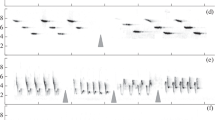Summary
This paper is concerned with the idea that the song repertoires of passerine birds are an evolutionary adaptation to reduce habituation in listeners. In an experiment involving 16 territorial males I played either a single song or a repertoire of songs for 15 two-min trials through a single loudspeaker near the edge of the territory. In a second experiment with 10 birds I played the songs through one of two loudspeakers in different parts of the territory, alternating between loudspeakers on successive trials. The birds tended to habituate more rapidly to single song playback than to repertoires. In the second experiment the overall level of habituation was lower and the difference between the two treatments was less marked.
Two features of song repertoire organisation are consistent with the habituation hypothesis (1) the avoidance of low recurrence intervals in switches between song types, and (2) the fact that within repertoire variability is as great or greater than between repertoire varability.
The main problem with the habituation hypothesis is that habituation by listeners does not seem to be adaptive, so it is not clear why they should habituate. I suggest a hypothesis. Intruders may assess the density of birds in an area by listening to songs, so that habituation may be a mechanism by which this density assessment is achieved. Repertoires could be a mechanism by which resident birds cheat, through increasing the apparent density of singing birds.
Similar content being viewed by others
References
Armstrong, E.A.: A study of bird song. New York: Dover Publ. Inc. 1973
Brooks, R.J., Falls, J.B.: Individual recognition by song in white-throated sparrows. I. Discrimination of songs of neighbours and strangers. Canad. J. Zool. 53, 879–888 (1975)
Dobson, D.W., Lemon, R.E.: Re-examination of monotony threshold hypothesis in bird song. Nature (Lond.) 257, 126–128 (1975)
Falls, J.B.: Functions of territorial songs in the white-throated sparrow. In: Bird vocalisations (Hinde, R.A. ed.), pp. 307–332. Cambridge: Univ. Press 1969
Falls, J.B., Krebs, J.R.: Sequence of songs in repertoires of Western Meadowlarks (Sturnella neglacta). Canad. J. Zool. 53, 1165–1178 (1975)
Gompertz, T.: The vocabulary of the Great Tit. Brit. Birds 54, 369–394, 409–418 (1961)
Hartshorne, C.: The monotony threshold in singing birds. Auk 93, 176–192 (1956)
Hartshorne, C.: Born to sing: an interpretation and world survey of bird song. Indiana Univ. Press 1973
Horn, G., Hinde, R.A.: Short term changes in neural activity and behaviour. Cambridge: Univ. Press 1970
Krebs, J.R.: Song and territory in the Great Tit. In: Evolutionary ecology. (Stonehouse, B., Perrins, C.M. eds.) London: Macmillan 1976a
Krebs, J.R.: Bird song and territory defence. New Scientist 70, 534–536 (1976b)
Krebs, J.R.: The significance of song repertoires: the Beau Geste hypothesis. Anim. Behav. (in press, 1977)
Krebs, J.R.: Song matching in the Great Tit (in prep.)
Kroodsma, D.: Song patterning in the rock wren. Condor 77, 294–303 (1975)
Lein, M.R.: Territorial and courtship songs of birds. Nature (Lond.) 237, 48–49 (1972)
Marler, P.: Tonal quality of bird sounds. In: Bird vocalisations, (Hinde, R.A. ed.) pp. 5–18. Cambridge: Univ. Press 1969
Morse, D.: Territorial and courtship songs of birds. Nature (Lond.) 226, 659–661 (1970)
Nelson, K.: Does the holistic study of behaviour have a future? In: Perspectives in ethology (Bateson, P.P.G., Klopfer, P.H., eds.), pp. 281–318. New York: Plenum Press 1973
Nottebohm, F.: Review of ‘Born to Sing’ by Hartshorne. Q. Rev. Biol. 48, 653–654 (1973)
Petronovich, L., Peeke, H.V.S.: Habituation to territoral song in the White-crowned sparrow (Zonotrichia leucophrys). Behav. Biol. 8, 743–748 (1973).
Schleidt, W.: Tonic communication: continual effects of discrete sings in animal communication systems. J. theor. Biol. 42, 359–386 (1973)
Todt, D.: Short term inhibition of outputs occurring in the vocal behaviour of blackbirds. J. comp. Physiol. 98, 289–306 (1975)
Verner, J., Milligan, M.: Responses of male white-crowned sparrows to playback of recorded song. Condor 73, 56–64 (1971)
Author information
Authors and Affiliations
Rights and permissions
About this article
Cite this article
Krebs, J.R. Habituation and song repertoires in the great tit. Behav Ecol Sociobiol 1, 215–227 (1976). https://doi.org/10.1007/BF00299198
Received:
Issue Date:
DOI: https://doi.org/10.1007/BF00299198




